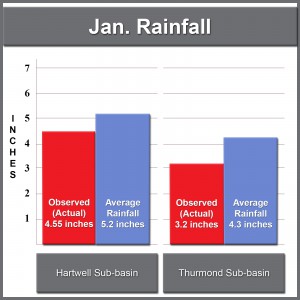For all the hubbub this year’s strong El Niño has generated among forecasters, January’s precipitation, which delivered about 80% of the average at each sub-basin, felt more underwhelming than the numbers suggest.
It’s like when LeBron James only scores 20 points.
Hartwell posted a respectable 4.55 inches  (5.23 in. average), while Russell and Thurmond fell about an inch short of their January averages (3.28 vs. 4.34, and 3.22 vs. 4.34, respectively).
(5.23 in. average), while Russell and Thurmond fell about an inch short of their January averages (3.28 vs. 4.34, and 3.22 vs. 4.34, respectively).
In addition, for the past three years the whole basin has fallen short of its January average (Thurmond’s sub-par streak actually goes back six years).
However, in light of December’s record-setting rainfall across the basin, perhaps January’s 80% is more than enough, especially when a larger percentage of that precipitation actually reaches the reservoirs in the winter compared to the summer because of lower rates of evapotranspiration.
Today, as a storm moved east across Georgia the sub-basins got a solid jumpstart on February’s precipitation: Hartwell, 1.87 inches; Russell, 1.92; and Thurmond, 1.47.
In their Jan. 21 “Water Resources Outlook” NOAA forecasters said there’s still a lot of winter and early spring left, and that we won’t be out of the wetter-than-average-conditions woods until April.
NOAA even predicted small bits of respite between larger swaths of rainfall, which should provide residents along the Savannah River Basin (and water managers) some time to regroup.
Still, the situation seems all too Chicken Little: Forecasters have been saying the sky will be falling for so long that you almost start to root for the rain, and feel let down when it doesn’t arrive or takes too long.
However, El Niño’s behavior hasn’t really strayed from forecasters’ predictions since October, and perhaps this isn’t the last we’ll see of this kid.
~ Jeremy S. Buddemeier, Corporate Communications Office


Jan respectfully asks that you consider inflows for its performance evaluation. Inflows from its “more than enough” rainfall were 1.64 times average and ranked as its eighth highest performance in 62 years. Saturated ground and recharged groundwater assisted a 17,756 cfs inflow rate compared to its average 10,797 cfs since 1954. :-)
NOAA justifiably focuses on El Niño event precipitation and temperature, but resulting inflows provide the bottom line for lake and river levels. The months of Feb – Apr average 11,920 cfs inflows, but they average 18,280 cfs for the five historical strong El Niño events and 24,560 cfs for the 1998 event. Inflows of this magnitude quickly fill the flood storage capacity of the lakes and typically result in downstream flooding, so our 54 members remain especially appreciative this year when water managers aggressively return lake levels to the Guide Curve.
Ferris,
Consider Jan.’s evaluation amended! Thanks for offering the inflow perspective. ~Jeremy
Regarding the Feb 10 Declaration and Projection, I would increase generation during the higher demand month of Feb rather than waiting for the 23% drop in Mar contract power to release the expected higher inflows. This year, reaching 330’/660′ by Apr 1 appears all but guaranteed, with the risk of additional flooding overshadowing the risk of lower lake levels. The Projection shows abundant excess generation during the least desirable months of Mar and Apr, allowing lower release rates in the unlikely event of much below normal inflows.